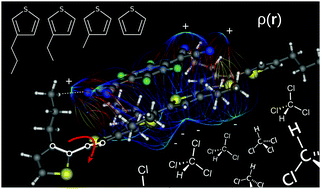Exploring organic semiconductors in solution: the effects of solvation, alkylization, and doping†
Abstract
The first-principles simulation of the electronic structure of organic semiconductors in solution poses a number of challenges that are not trivial to address simultaneously. In this work, we investigate the effects and the mutual interplay of solvation, alkylization, and doping on the structural, electronic, and optical properties of sexithiophene, a representative organic semiconductor molecule. To this end, we employ (time-dependent) density functional theory in conjunction with the polarizable-continuum model. We find that the torsion between adjacent monomer units plays a key role, as it strongly influences the electronic structure of the molecule, including energy gap, ionization potential, and band widths. Alkylization promotes delocalization of the molecular orbitals up to the first methyl unit, regardless of the chain length, leading to an overall shift of the energy levels. The alterations in the electronic structure are reflected in the optical absorption, which is additionally affected by dynamical solute–solvent interactions. Taking all these effects into account, solvents decrease the optical gap by an amount that depends on its polarity, and concomitantly increase the oscillator strength of the first excitation. The interaction with a dopant molecule promotes planarization. In such scenario, solvation and alkylization enhance charge transfer both in the ground state and in the excited state.



 Please wait while we load your content...
Please wait while we load your content...